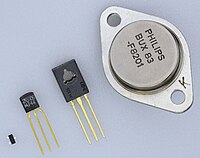
Photo from wikipedia
Phosphorus-doped hierarchically porous carbon (HPC) is prepared with the assistance of freeze-drying using colloid silica and phytic acid dipotassium salt as a hard template and phosphorus source, respectively. Intensive material… Click to show full abstract
Phosphorus-doped hierarchically porous carbon (HPC) is prepared with the assistance of freeze-drying using colloid silica and phytic acid dipotassium salt as a hard template and phosphorus source, respectively. Intensive material characterizations show that the freeze-drying process can effectively promote the porosity of HPC. The specific surface area and P content for HPC can reach up to 892 m2 g−1 and 2.78 at%, respectively. Electrochemical measurements in aqueous KOH and H2SO4 electrolytes reveal that K+ of a smaller size can more easily penetrate the inner pores compared with SO42−, while the developed microporosity in HPC is conducive to the penetration of SO42−. Moreover, P-doping leads to a high operation potential of 1.5 V for an HPC-based symmetric supercapacitor, resulting in an enhanced energy density of 16.4 Wh kg−1. Our work provides a feasible strategy to prepare P-doped HPC with a low dosage of phosphorus source and a guide to construct a pore structure suitable for aqueous H2SO4 electrolyte.
Journal Title: Nanomaterials
Year Published: 2021
Link to full text (if available)
Share on Social Media: Sign Up to like & get
recommendations!